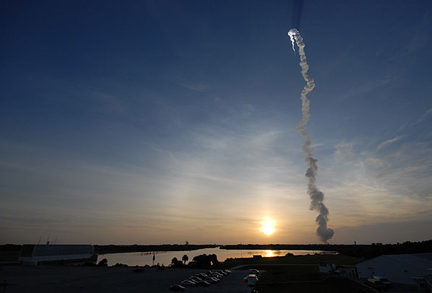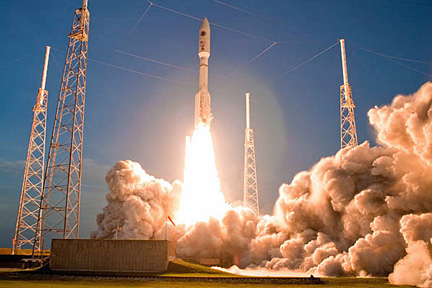Advanced EHF comsat launched
08/14/2010 08:06 AM Filed in: Space News | EELV
A United Launch Alliance Atlas 5 rocket boosted a costly new Air Force communications satellite into space Saturday, the first of three high-speed, jam-resistant relay stations that together are valued at more than $6 billion.
The towering Atlas 5 roared to life at 7:07 a.m. EDT and majestically climbed away from launch complex 41 at the Cape Canaveral Air Force Station atop a rush of flame from its Russian RD-180 first stage engine and three strap-on solid-fuel motors.
 A United Launch Alliance rocket boosts the first Advanced EHF
A United Launch Alliance rocket boosts the first Advanced EHF
military communications satellite into orbit
(Photo: Ben Cooper/Spaceflight Now)
The towering Atlas 5 roared to life at 7:07 a.m. EDT and majestically climbed away from launch complex 41 at the Cape Canaveral Air Force Station atop a rush of flame from its Russian RD-180 first stage engine and three strap-on solid-fuel motors.
 A United Launch Alliance rocket boosts the first Advanced EHF
A United Launch Alliance rocket boosts the first Advanced EHFmilitary communications satellite into orbit
(Photo: Ben Cooper/Spaceflight Now)
Arcing eastward toward the rising sun, the rocket quickly built up speed, its strap-on boosters and first stage dropping away on schedule before a final push to space using the single RL-10 engine in its Centaur second stage..
After a second firing of the Centaur, the Advanced Extremely High Frequency satellite was released into a planned initial orbit with a low point, or perigee, of around 103 miles and a high point, or apogee, of 19,322 miles.
Using on-board thrusters, the satellite will be maneuvered into its final 22,300-mile circular orbit over the next three months for tests and checkout before going into active service.
The Advanced EHF satellite features sophisticated anti-jamming technology, high-speed communications and enhanced survivability. Built by Lockheed Martin Space Systems Co., the Advanced EHF is a follow-on to the Milstar system, providing secure communications at data rates 10 times higher than earlier satellites.
 Liftoff of a United Launch Alliance rocket carrying the first
Liftoff of a United Launch Alliance rocket carrying the firstAdvanced EHF military communications satellite.
(Photo: Pat Corkery/United Launch Alliance
Saturday's launching marks the "beginning of a new era in protected satcom," said Col. William Harding, vice commander of the Military Satellite Communications Systems Wing at Los Angeles Air Force Base. "AEHF 1 will provide more protected capacity than the entire legacy Milstar constellation."
Along with faster, more secure communications, "AEHF also will provide a five-fold increase in the numbers of communication coverage opportunities so that more terminals spread over more of the globe will be able to access more communications resources.
"AEHF will provide an order of magnitude (increase) in capacity over the Milstar constellation," he said. "These improvements mean that users will be able to process and receive data faster than ever."